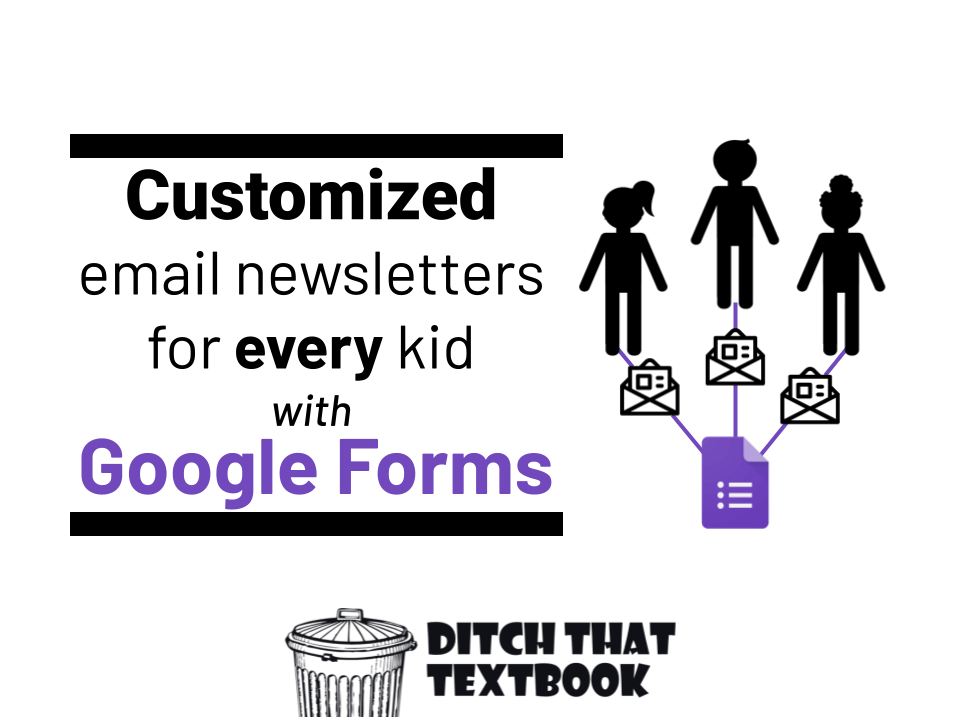
Make solid connections with families by creating custom email newsletters for every student. It's easy with Google Docs, Sheets and Forms.
Classroom newsletters are kind of hit and miss.
You know how they usually look. If you send one, you're probably printing and copying a standard newsletter that every kid gets -- in hopes that maybe, just maybe, a parent might actually read it.
If you're sending photocopies of them home in students' backpacks, I'll bet your success rate is less than 50 percent. (And that's being generous.) Parents don't even get them many times ... and you know that as well as I do!
There's a big reason I believe that these newsletters -- which could be great parent/teacher communication tools -- fall short.
They're not personalized. If parents knew there would be comments unique to their children, they'd be much more likely to read them.
That's possible now -- for free. And it doesn't take much more time than a regular newsletter.
Using a combination of Google Docs and Google Sheets (with an option to use Google Forms to input information), you can create personalized email newsletters with custom comments for every student.
How customized email newsletters save time and boost learning
We teachers aren't the only ones who are pulling for our students' success.
Most of those kids have allies at home -- parents, guardians, really anyone who loves them and wants the best for them.
We can team up -- student, parents, and teacher -- pushing and pulling in the same direction to get better results.
Teaching something at school? If parents know about it, they might ask their kid about it. They might ask the kid to teach it to them. They might even embed it in normal home activities. That is ... if they know what it is and have some suggestions on how to do it.
That's where these custom email newsletters are a hit!
In a short amount of time, you can write a message that all the families get. You can write a short personal message about each kid that gets delivered individually to each student's family.
Then, you click "send" and it's all merged together in one custom email newsletter.
Families are in the loop. And if they're paying attention and are willing to help, you might not spend as much time reminding, reteaching, and reviewing as you might otherwise.
Plus, when families feel like they're involved and connected, it becomes part of their identity. "We're a family that really emphasizes education." That identity goes a long way day by day to helping that student succeed.
What could I include in these newsletters?
The easy answer? Think about what you’d tell your students’ families if they were in your classroom face to face. This is your opportunity to get personal, sharing ideas for success, notable insights, and areas for improvement.
Here are some ideas of what you could share that's customized to each student:
- Positive things you’ve noticed about the student since the last newsletter
- Areas for improvement
- Positive character traits you’ve noticed
- Missing assignments
- Kudos for great work on assignments turned in
- An update on their goals since the last newsletter
You can also include a section of the newsletter that everyone gets -- that you don’t customize for each student. There’s a lot you can share there, too …
- Upcoming deadlines, projects, assignments, etc.
- School wide events or assemblies
- Observations about how learning is going in your classroom
- Interesting classroom stories that parents might want to know
- Updates from the school and district
- Quotes, videos, or motivation for families and/or students
Sixth grade virtual teacher Monica Willis shares these suggestions to send in newsletters ...
- Links to recorded lessons
- Links to toolkits I've created
- Exemplars of projects
- Shoutouts to the class for mastering a skill or behavior (getting to class on time, opening work when asked the first time, etc.)
- Tips for focusing and prioritizing
So ... how do I create a customized email newsletter?
My favorite way to create custom newsletters is to use the Autocrat add-on. It's a way to take data from a Google Sheet spreadsheet and merge it into a Google Docs template automatically.
Autocrat is very versatile. I've written about how you can use Autocrat and Google Forms to create "The Magic Automatic Lesson Planner." There are other Autocrat suggestions in this post on practical ways to use Google Forms in schools.
It's pretty simple. Check out our step-by-step video tutorial video or scroll down to read the steps below:
Note: This video walks you through using Google Forms to create and send the newsletters. If you want to use the Google Sheets option scroll down to read the tutorial below. The templates mentioned in the video are the Class Newsletter template and the Newsletter input form template which you can find by clicking on the links or within the tutorial below.
1. Design your newsletter in Google Docs.
Create a new document and start filling it with the information you want to pass along to parents. When you come to a place where you want to provide custom information for each child, just mark that with a merge tag.
- Wait ... what's a merge tag? This is how Autocrat will know where to put your custom comments for each student. A merge tag might look like this: <<name>>. That's the one I used in my newsletter to add student names to each unique custom newsletter. It doesn't matter what word or words you put in your merge tags, so use something that you'll be able to remember. (i.e. <<goals>> for a section on goals for that particular student)
Click here to make a copy of my newsletter template, or see the image below.
2. When you're done designing your newsletter, you have a decision to make.
How do you want to type all of the comments for each student for all of your custom newsletters? There are two basic options:
- Type them directly into a Google Sheets spreadsheet.
- Enter them in a Google Forms survey that you create just for your own use.
If you choose the Google Sheets route ...
Create a new Google Sheet. Make the top row of your sheet the headers for all of the columns of data that you want to use. (See my example here. I used student name, a general note about the student, what they're good at and their goals -- four columns.)
This is a nice option because you can type all of your student names and email addresses into the sheet once. Then, when you create your next newsletter, you can copy the names and email addresses and paste them below so you don't have to enter them all over again. You can copy my Google Sheets template here.
If you choose the Google Forms route ...
Create a new Google Form. When you make this form, you're creating a custom survey that you can use over and over to insert new comments quickly. Click the "+" button and add the kinds of fields/questions that you want. (Click here to make a copy of my template.)
Some suggestions:
- If you're typing full-sentence or paragraph-length comments for the newsletter, you should probably add the "paragraph" fields for each of those.
- For anything you'll type that's just one word or a short phrase, "short answer" fields are best.
- For student name and email address, one option is to create a "dropdown" field and enter their data there -- one for name and one for email address. That way, when you enter comments for each student, you won't have to type his/her name and email address each time -- just choose it from a dropdown menu.
Whenever you add data through your Google Forms survey, that data is automatically saved to the form (click the "Responses" tab). You can also create or choose a spreadsheet where you want the data to go, too. To do this, from the "Responses" tab, click the little green spreadsheet icon. You'll choose whether you create a brand new spreadsheet for the data or you add it to an existing one. I almost always create a new spreadsheet to go with my Forms surveys. (You'll want to do this before you use Autocrat in step 4.)
3. Start entering data.
If you're using a Google Sheet, start typing data -- name, email address and comments -- into your sheet. If you're using a Google Form, start typing data into the form and submitting once for each student. It will be collected and put into a spreadsheet automatically. (Note: I like to add some data to myself so that I get a copy of the newsletter in my own email and make sure that it worked correctly. So you might add your own name, email address and some dummy data to send to yourself.)
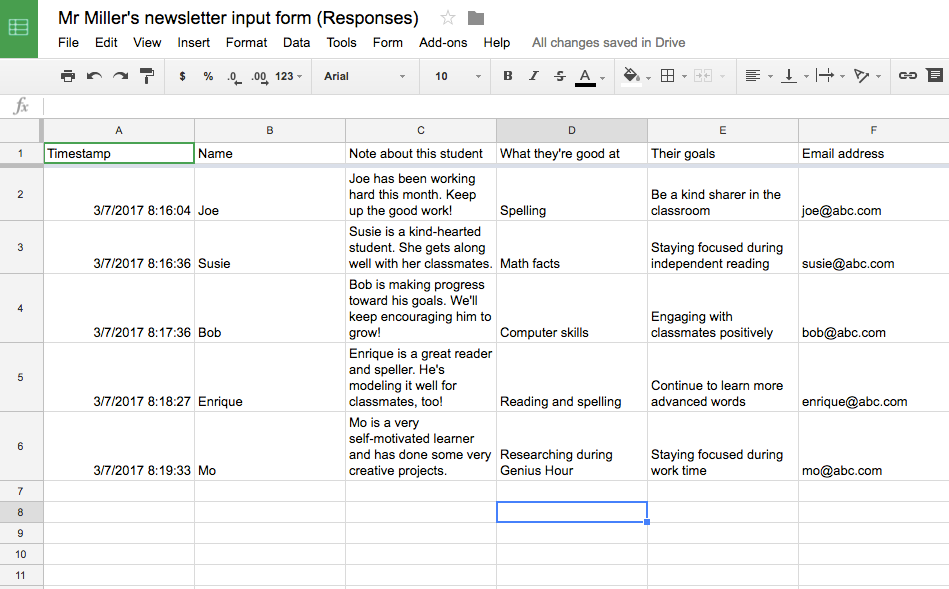
4. Set up Autocrat to put data into the newsletters.
You have your newsletter designed in Docs, right? And you've typed personalized data for all of your students? Great.
It's time to make the magic happen.
Open your Google Sheets spreadsheet of data. In the menu bar, choose "Add-ons" and "Get add-ons". Search for "Autocrat" in the search bar. Click the "+ Free" button and it will be added to your sheet. (Note: If you've used Autocrat before, you won't need this step.)
In the menu bar, choose "Add-ons" > "Autocrat" > Launch. Click the "New Job" button and you're off to the races!
Step 1: Job name.
No one will see this but you. Example: "Mr. Miller's newsletter." Click "next."
Step 2: Choose a template.
This is the document you created earlier with the merge tags in it. Click "From Drive" and find the document you made earlier. Click "next."
Step 3: Map source data to template.
This sounds complicated but it's not. You just tell Autocrat what data to put in the document for your merge tags. For each merge tag, choose what data you want to use from the dropdown menu next to the words "maps to column". (See below.) Make sure you scroll down and do all of them. Click "next."
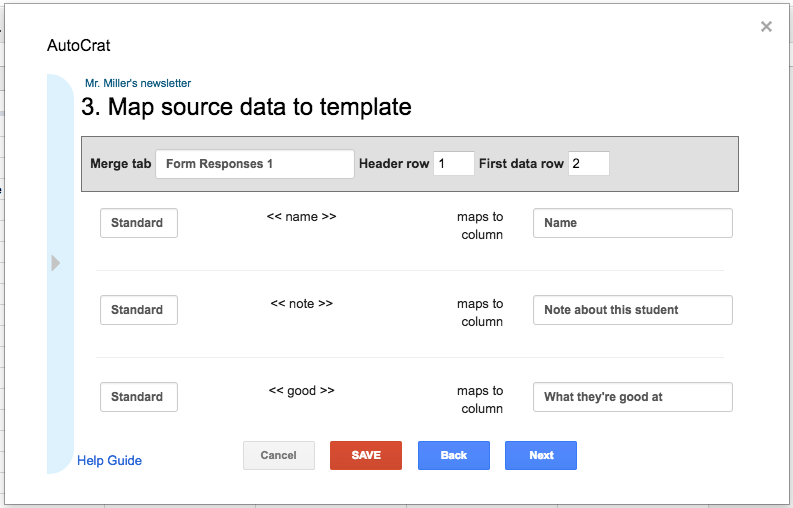
Step 4: File settings.
This is where you decide what kind of file you'll create for each student and how its file name will be created. My suggestion: Click on the blue bar on the left and copy the merge tag for student name. Use it in the file name along with the date/month of the newsletter. (See example below.) Choose whether you want to create a PDF or Google Doc. (I usually choose PDF, but it's up to you.) Finally, you want multiple documents, not a single document. Click "next."
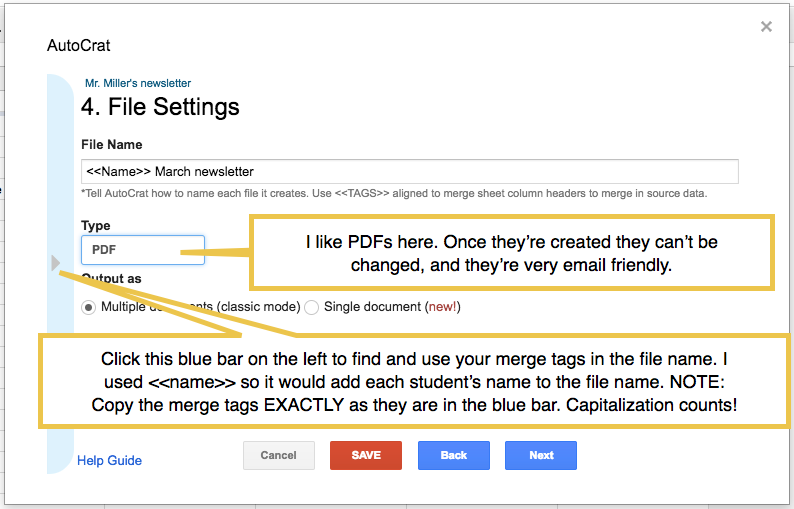
Step 5: Choose destination folder(s).
This is where all of your personalized student newsletters will be saved in your Google Drive. Go to your Google Drive (drive.google.com) and click "New" > "New folder ..." and make a folder for your newsletters. When you're done, come back to Autocrat and click the "+ Choose Folder" button to choose that folder. (Note: When you choose a folder, don't double-click it. That opens the folder. Single click it to select it. Then click the blue "Select" button at the bottom.) Click "next."
Step 6: Add dynamic folder reference (optional).
Skip this step. Click "next."
Step 7: Set merge condition (optional).
Skip this step. Click "next."
Step 8: Share docs and send emails.
Where it says, "Share Doc?" choose "yes." It's probably easiest to leave the first three options as they are, but you can definitely change them. (Share doc as: PDF; Allow collaborators to re-share: Yes; Send from generic no-reply address: No.)
Below that, you'll craft your email to parents. You'll want to copy the email address using the blue bar on the left. (Click the blue bar and click the merge tag for the email address. When you click it, it copies it so you can paste it later.) Paste that into the "To:" field.
Type a subject line for your email. Parents are going to be more likely to open it if it has their child's name in the subject line. Again, use the blue bar on the left to copy the merge tag for student name. Put it in the subject line. Example: "<<name>>'s March newsletter"
Then, type your email. Remember, every parent gets the same email, so write something that fits for everyone. When you're done, click "next."
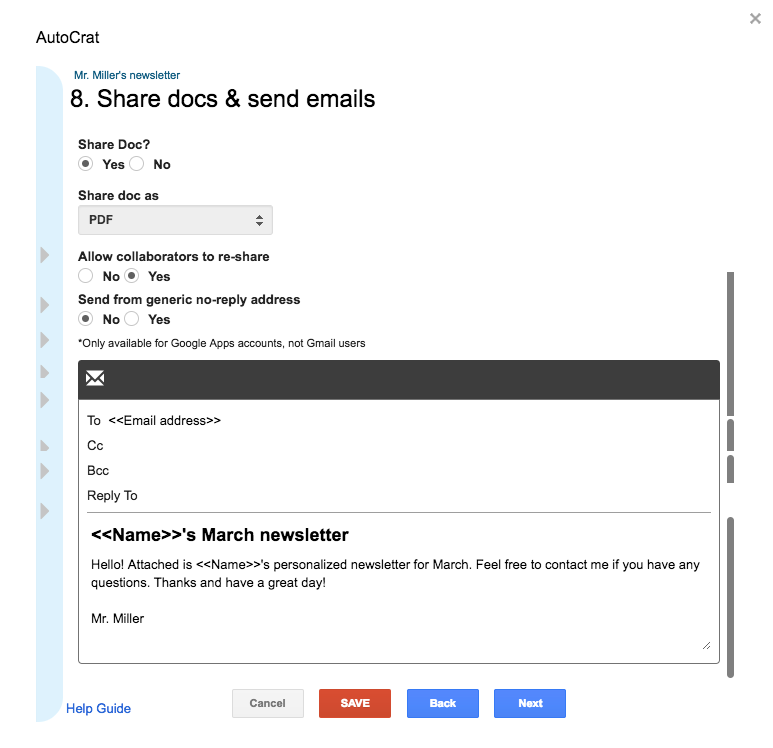
Step 9: Add/remove job triggers.
This is how you tell Autocrat when and how to send your emails. For our newsletter purposes, you don't want to run on form trigger. (This only works if you're adding data to the sheet from a Google Form, and it would send a newsletter every time you submit the form. Unless you want to do that ...) You also don't want to run on time trigger. (This makes Autocrat look for new data to create newsletters every hour, every six hours, etc.)
So to keep things simple, just leave both of these as "no." Click "SAVE."
5. Send those newsletters!
Once you click "SAVE" above, you'll be returned to the "Existing jobs" screen, which looks like this:
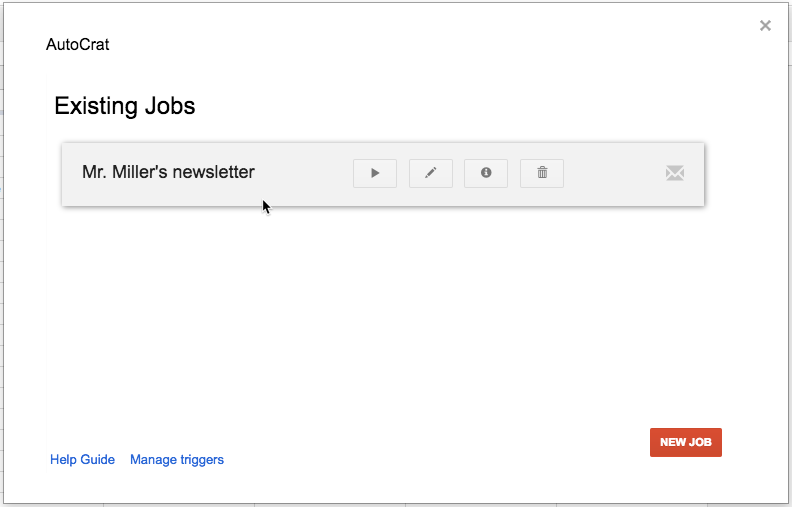
You can find the "Existing jobs" screen by clicking Add-ons > Autocrat > Open in the menu bar.
Click the "play" button to create all of your newsletters and send them! (That's the little triangle button.)
Note: It takes Autocrat a while to create and send them all. You can watch the progress on your spreadsheet ... it makes notes of what it's doing to the right of all of your data in your spreadsheet.
Your emails should be on their way!
What do I do the next time I want to send a newsletter?
Easy peasy ...
If you're adding data with a Google Form, just use that form to enter data for each student for your new newsletter. Go to your newsletter document and update whatever you need (i.e. new announcements, etc.). Then go to Add-ons > Autocrat > Open and run Autocrat to send the new newsletters.
If your'e adding data with a Google Sheet, copy all the student names and email addresses and paste them below the old data. Type new comments for each student. Go to your newsletter document and update whatever you need (i.e. new announcements, etc.). Then go to Add-ons > Autocrat > Open and run Autocrat to send the new newsletters.
Wash. Rinse. Repeat ... as many times as you want to create new newsletters!
Wow. That was really easy!
Wasn't it? It's a simple approach to building relationships at home, giving parents some specific feedback on their kids and keeping everyone in the loop.
For notifications of new Ditch That Textbook content and helpful links:
Are you looking for quality, meaningful professional learning that both equips and inspires teachers?
Matt provides in-person and virtual keynotes, workshops and breakout sessions that equip, inspire and encourage teachers to create change in their classrooms. Teachers leave with loads of resources. They participate. They laugh. They see tech use and teaching in a new light. Click the link below to contact us and learn how you can bring Matt to your school or district!
Is Matt presenting near you soon? Check out his upcoming live events!

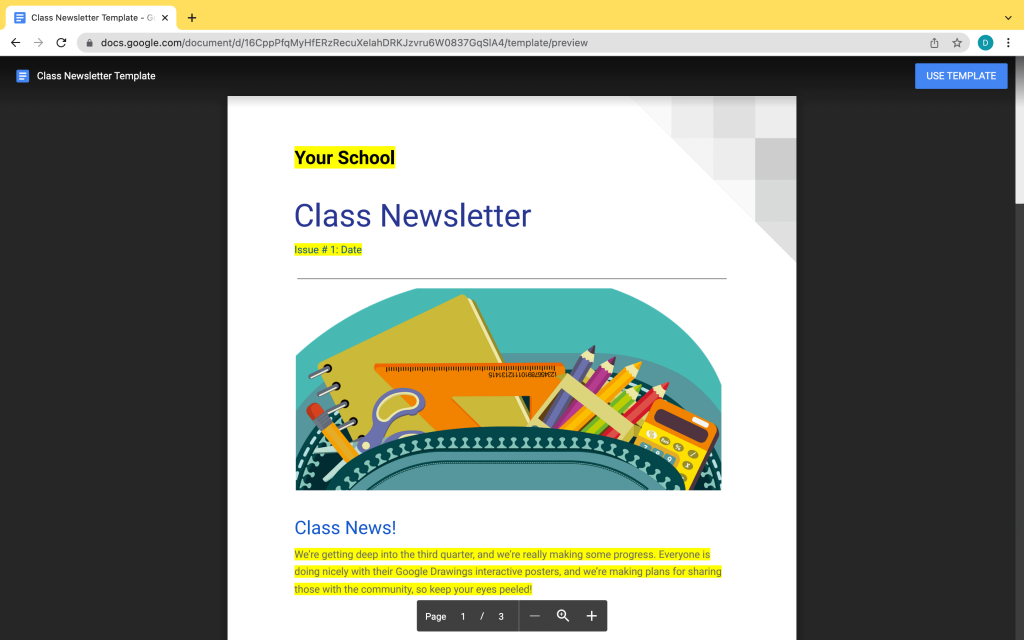
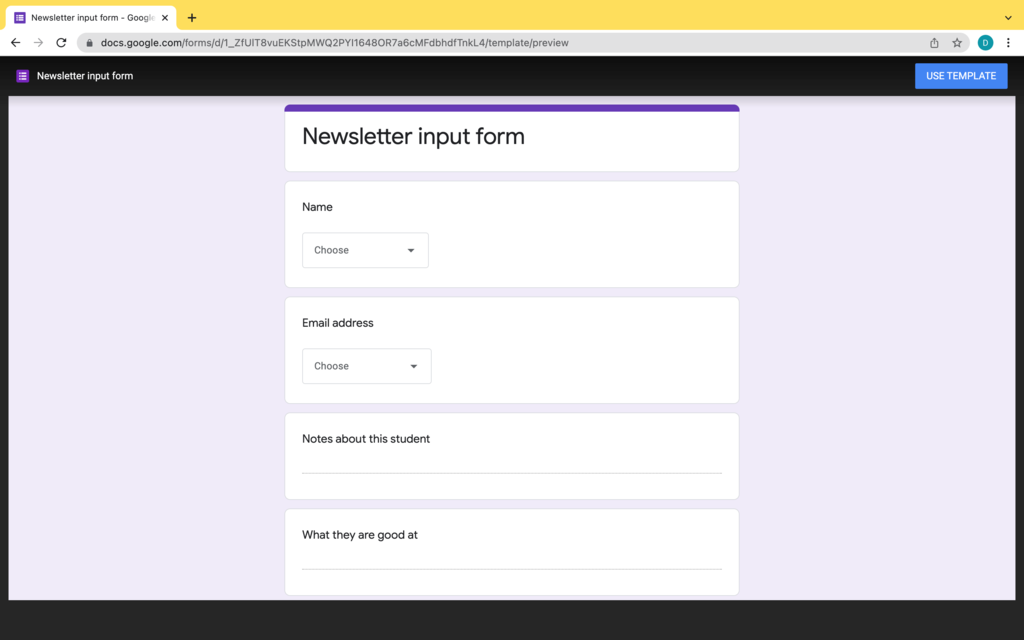


Thank you!
Thank you!
Great article really impressed me. I think you should also write an article about cnc bike accessories. This will be beneficial for others I guess thank you for sharing
Such a cool idea! Is anyone else noticing that the Autocrat link is broken?
Personalized newsletters are amazing!
Thank you !
As a secondary teacher, newsletters are not typically the norm, but as I read this I was thinking of a way to boost parent communication at the secondary level. With 150 or so students, personal comments for a newsletter may seem like an insurmountable task, but what if the form was shared with students for them to fill in information about how they feel they are doing in class. The teacher could go back and personalize for students whose parents need to be directly contacted, or could write personalized messages to a few kids from each class. What potential hang ups do you see with this?
[…] Customized email newsletters for every kid with Google Forms | Ditch That Textbook […]
[…] love these customized emails! Wouldn’t it be neat to share thoughts about each student’s proficiency and progress […]
Love this – could be a game changer for parent communication for a lot of teachers. Would it be possible for you to make a screencast of the process?